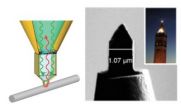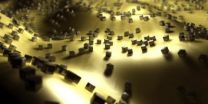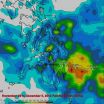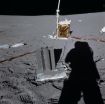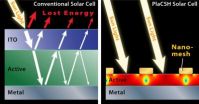(Press-News.org) If nanoscience were television, we'd be in the 1950s. Although scientists can make and manipulate nanoscale objects with increasingly awesome control, they are limited to black-and-white imagery for examining those objects. Information about nanoscale chemistry and interactions with light—the atomic-microscopy equivalent to color—is tantalizingly out of reach to all but the most persistent researchers.
But that may all change with the introduction of a new microscopy tool from researchers at the Department of Energy (DOE)'s Lawrence Berkeley National Laboratory (Berkeley Lab) that delivers exquisite chemical details with a resolution once thought impossible. The team developed their tool to investigate solar-to-electric energy conversion at its most fundamental level, but their invention promises to reveal new worlds of data to researchers in all walks of nanoscience.
"We've found a way to combine the advantages of scan/probe microscopy with the advantages of optical spectroscopy," says Alex Weber-Bargioni, a scientist at the Molecular Foundry, a DOE nanoscience center at Berkeley Lab. "Now we have a means to actually look at chemical and optical processes on the nanoscale where they are happening."
Weber-Bargioni is corresponding author of a paper reporting this research, published in Science. The paper is titled, "Mapping local charge recombination heterogeneity by multidimensional nanospectroscopic imaging." Co-authoring the paper are Wei Bao, Mauro Meli, Frank Ogletree, Shaul Aloni, Jeffrey Bokor, Stephano Cabrini, Miquel Salmeron, Eli Yablonovitch, and James Schuck of Berkeley Lab; Marco Staffaroni of the University of California, Berkeley; Hyuck Choo of Caltech; and their colleagues in Italy, Niccolo Caselli, Francesco Riboli, Diederik Wiersma, and Francesca Intoni.
"If you want to characterize materials, particularly nanomaterials, the way it's traditionally been done is with electron microscopies and scan/probe microscopies because those give you really high, sub-atomic spatial resolution," says co-author James Schuck, a nano-optics researcher at the Molecular Foundry. "Unfortunately, what they don't give you is chemical, molecular-level information."
For chemical information, researchers typically turn to optical or vibrational spectroscopy. The way a material interacts with light is dictated to large part by its chemical composition, but for nanoscience the problem with doing optical spectroscopy at relevant scales is the diffraction limit, which says you can't focus light down to a spot smaller than approximately half its wavelength, due to the wave-nature of light.
To get around the diffraction limit, scientists employ "near-field" light. Unlike the light we can see, near-field light decays exponentially away from an object, making it hard to measure, but it contains very high resolution—much higher than normal, far-field light.
Says Schuck, "The real challenge to near-field optics, and one of the big achievements in this paper, is to create a device that acts as a transducer of far-field light to near-field light. We can squeeze it down and get very enhanced local fields that can interact with matter. We can then collect any photons that are scattered or emitted due to this interaction, collect in the near field with all this spatial frequency information and turn it back into propagating, far-field light."
The trick for that conversion is to use surface plasmons: collective oscillations of electrons that can interact with photons. Plasmons on two surfaces separated by a small gap can collect and amplify the optical field in the gap, making a stronger signal for scientists to measure.
Researchers have exploited these effects to make near-field probes with a variety of geometries, but the experiments typically require painstaking optical alignment, suffer from background noise, only work for narrow frequency ranges of light and are limited to very thin samples.
In this latest work, however, the Berkeley Lab researchers transcended these limitations with a cleverly designed near-field probe. Fabricated on the end of an optical fiber, the probe has a tapered, four-sided tip. The researchers named their new tool after the campanile church tower it resembles, inspired by the landmark clock tower on the UC Berkeley campus. Two of the campanile's sides are coated with gold and the two gold layers are separated by just a few nanometers at the tip. The three-dimensional taper enables the device to channel light of all wavelengths down into an enhanced field at the tip. The size of the gap determines the resolution.
In a regular atomic force microscope (AFM), a sharp metal tip is essentially dragged across a sample to generate a topological map with sub-nanoscale resolution. The results can be exquisite but only contain spatial information and nothing about the composition or chemistry of the sample.
Replacing the usual AFM tip with a campanile tip is like going from black-and-white to full color. You can still get the spatial map but now there's a wealth of optical data for every pixel on that map. From optical spectra, scientists can identify atom and molecule species, and extract details about electronic structure.
"That's the beauty of these tips," says Schuck. "You can just put them on the end of an optical fiber and then it's just like using a regular AFM. You don't have to be a super near-field jock anymore to get this type of data."
The team developed their new tool to study indium-phosphide nanowires. These nanowires, with the nearly ideal band gap of 1.4 electron-volts, are well-suited to converting solar energy to electricity. The researchers found that the nanowires were not the homogeneous objects previously thought, but instead had varying optoelectronic properties along their length, which could radically alter how sunlight is converted to electricity. They also found that photoluminescence, an indication of the relationship between light and electricity, was seven-times stronger in some parts of a nanowire than others. This is the first time anyone has measured these events on such a small scale.
Weber-Bargioni says: "Details like this about indium-phosphide nanowires are important because if you want to use these suckers for photocatalysis or a photovoltaic material then the length scale at which we're measuring is where everything happens. This information is really important to understand how, for example, the fabrication and surface treatment of nanowires influences these charge recombination velocities. These determine how efficiently a solar device can convert photons into usable electrons."
Adds Schuck: "We realized that this is really the optimal way to do any kind of optical experiment one might want to do at the nano scale. So we use it for imaging and spectroscopy but we anticipate many other uses also."
INFORMATION:
This research was supported by the DOE Office of Science.
Lawrence Berkeley National Laboratory addresses the world's most urgent scientific challenges by advancing sustainable energy, protecting human health, creating new materials, and revealing the origin and fate of the universe. Founded in 1931, Berkeley Lab's scientific expertise has been recognized with 13 Nobel prizes. The University of California manages Berkeley Lab for the U.S. Department of Energy's Office of Science. For more, visit www.lbl.gov.
The Molecular Foundry is one of five DOE Nanoscale Science Research Centers (NSRCs), national user facilities for interdisciplinary research at the nanoscale, supported by the DOE Office of Science. Together the NSRCs comprise a suite of complementary facilities that provide researchers with state-of-the-art capabilities to fabricate, process, characterize, and model nanoscale materials, and constitute the largest infrastructure investment of the National Nanotechnology Initiative. The NSRCs are located at DOE's Argonne, Brookhaven, Lawrence Berkeley, Oak Ridge and Sandia and Los Alamos national laboratories. For more information about the DOE NSRCs, please visit http://science.energy.gov/bes/suf/user-facilities/nanoscale-science-research-centers/.
DOE's Office of Science is the single largest supporter of basic research in the physical sciences in the United States, and is working to address some of the most pressing challenges of our time. For more information, please visit the Office of Science website at science.energy.gov/.
Seeing in color at the nanoscale
Berkeley Lab scientists develop a new nanotech tool to probe solar-energy conversion
2012-12-07
ELSE PRESS RELEASES FROM THIS DATE:
Notre Dame research reveals migrating Great Lakes salmon carry contaminants upstream
2012-12-07
Be careful what you eat, says University of Notre Dame stream ecologist Gary Lamberti.
If you're catching and eating fish from a Lake Michigan tributary with a strong salmon run, the stream fish — brook trout, brown trout, panfish — may be contaminated by pollutants carried in by the salmon.
Research by Lamberti, professor and chair of biology, and his laboratory has revealed that salmon, as they travel upstream to spawn and die, carry industrial pollutants into Great Lakes streams and tributaries. The research was recently published in the journal Environmental Science ...
Silver nanocubes make super light absorbers
2012-12-07
DURHAM, N.C. -- Microscopic metallic cubes could unleash the enormous potential of metamaterials to absorb light, leading to more efficient and cost-effective large-area absorbers for sensors or solar cells, Duke University researchers have found.
Metamaterials are man-made materials that have properties often absent in natural materials. They are constructed to provide exquisite control over the properties of waves, such as light. Creating these materials for visible light is still a technological challenge that has traditionally been achieved by lithography, in which ...
NASA compiles Typhoon Bopha's Philippines Rainfall totals from space
2012-12-07
NASA's Tropical Rainfall Measuring Mission, or TRMM satellite can estimate rainfall rates from its orbit in space, and its data is also used to compile estimated rainfall totals. NASA just released an image showing those rainfall totals over the Philippines, where severe flooding killed several hundred people. Bopha is now a tropical storm in the South China Sea.
High winds, flooding and landslides from heavy rains with Typhoon Bopha have caused close to 300 deaths in the southern Philippines.
The TRMM satellite's primary mission is the measurement of rainfall in the ...
UC Davis study shows that treadmill testing can predict heart disease in women
2012-12-07
(SACRAMENTO, Calif.) — Although there is a widespread belief among physicians that the exercise treadmill test (ETT) is not reliable in evaluating the heart health of women, UC Davis researchers have found that the test can accurately predict coronary artery disease in women over the age of 65. They also found that two specific electrocardiogram (EKG) indicators of heart stress during an ETT further enhanced its predictive power.
Published in the December issue of The American Journal of Cardiology, the study can help guide cardiologists in making the treadmill test ...
TGen-US Oncology data guides treatment of metastatic triple-negative breast cancer patients
2012-12-07
PHOENIX, Ariz. — Dec. 6, 2012 — Genomic sequencing has revealed therapeutic drug targets for difficult-to-treat, metastatic triple-negative breast cancer (TNBC), according to an unprecedented study by the Translational Genomic Research Institute (TGen) and US Oncology Research.
The study is published by the journal Molecular Cancer Therapeutics and is currently available online.
By sequencing, or spelling out, the billions of letters contained in the genomes of 14 tumors from ethnically diverse metastatic TNBC patients, TGen and US Oncology Research investigators found ...
General thoracic surgeons emerge as leading providers of complex, noncardiac thoracic surgery
2012-12-07
While thoracic surgeons are traditionally known as the experts who perform heart surgeries, a UC Davis study has found that general thoracic surgeons, especially those at academic health centers, perform the vast majority of complex noncardiac operations, including surgeries of the esophagus and lungs.
The authors said their results, published in the October issue of The Annals of Thoracic Surgery, support the designation of general thoracic surgery as a distinct specialty, which will benefit patients when selecting surgeons for specific procedures.
"In years past, ...
Apollo's lunar dust data being restored
2012-12-07
Forty years after the last Apollo spacecraft launched, the science from those missions continues to shape our view of the moon. In one of the latest developments, readings from the Apollo 14 and 15 dust detectors have been restored by scientists with the National Space Science Data Center (NSSDC) at NASA's Goddard Space Flight Center in Greenbelt, Md.
"This is the first look at the fully calibrated, digital dust data from the Apollo 14 and 15 missions," said David Williams, a Goddard scientist and data specialist at NSSDC, NASA's permanent archive for space science mission ...
December 2012 Story Tips
2012-12-07
DISASTER RESPONSE – Limiting access . . .
Ensuring that only people who have legitimate business are allowed to enter areas hit by floods, hurricanes or other disasters is a big challenge, but Credentialing 2.0 offers a software solution. "Obviously, first responders, utility crews, tree cutters, disaster relief workers and members of the media have reasons to be on the scene, but there's no efficient way to control access," said Oak Ridge National Laboratory's David Resseguie, who leads the Credentialing 2.0 development team. The ORNL system helps officials to control ...
Combining two genome analysis approaches supports immune system contribution to autism
2012-12-07
Researchers using novel approaches and methodologies of identifying genes that contribute to the development of autism have found evidence that disturbances in several immune-system-related pathways contribute to development of autism spectrum disorders. The report published December 4 in the open-access journal PLOS ONE powerfully supports a role for the immune function in autism by integrating analysis of autism-associated DNA sequence variations with that of markers identified in studies of families affected by autism.
"Others have talked about immune function contributions ...
Tiny structure gives big boost to solar power
2012-12-07
Princeton researchers have found a simple and economic way to nearly triple the efficiency of organic solar cells, the cheap and flexible plastic devices that many scientists believe could be the future of solar power.
The researchers, led by electrical engineer Stephen Chou, were able to increase the efficiency 175 percent by using a nanostructured "sandwich" of metal and plastic that collects and traps light. Chou said the technology also should increase the efficiency of conventional inorganic solar collectors, such as standard silicon solar panels, although he cautioned ...
LAST 30 PRESS RELEASES:
Nearly 1 in 5 UK emergency department patients cared for in corridors/waiting rooms
Heavy energy drink intake may pose serious stroke risk, doctors warn
Violence against women and children among top health threats: New global study reveals disease burden far larger than previously estimated
Predicting who is at risk of developing type 1 diabetes, as new drugs now available
New gene-mapping method unlocks hidden drivers of cancer
Ocean current and seabed shape influence warm water circulation under ice shelves
Call to increase funding for ‘invisible’ Deaf victim-survivors of domestic abuse
University of Maryland School of Medicine names distinguished scientist and academic leader Gerald M. Wilson, PhD, as Chair of the Department of Biochemistry and Molecular Biology
Receptors in mammary glands make livestock and humans inviting hosts for avian flu
Icy hot plasmas
Treating adults with autism: Maryland Clinical Center offers national blueprint for care after pediatric transition
University of Phoenix College of Doctoral Studies releases white paper on reclaiming control to build workforce resilience
NCCN Summit seeks to improve care for veterans and first responders with cancer from line-of-duty exposure
ERC Consolidator Grant for soft robotics researcher
Dual-action arts and wellbeing program transforms dementia care
The global plastic waste trade contributes to coastal litter in importing countries, study shows
UT Dallas partners with Tech Mahindra on AI innovation
Blinking less could signal the brain is working harder to listen, Concordia study shows
Male bonobos track females’ reproductive cycle to maximize mating success
New report outlines science priorities for human Mars exploration
Want to curb cannabis-related crashes? Don’t forget older adults, study finds
Expectant management vs medication for patent ductus arteriosus in preterm infants
Pew funds 7 new biomedical research collaborations
The ERC selects 349 mid-career researchers for €728 million in Consolidator Grants
ERC Consolidator Grant awarded to CISPA researcher Rayna Dimitrova
Antimicrobial effects of Syzygium aromaticum and Salvadora persica against common peri-implantitis pathogens in vitro
EVs pose no greater risk to pedestrians than conventional vehicles
Modeling microplastic accumulation under the ocean surface
Pompeii offers insights into ancient Roman building technology
University of Utah engineers give a bionic hand a mind of its own
[Press-News.org] Seeing in color at the nanoscaleBerkeley Lab scientists develop a new nanotech tool to probe solar-energy conversion
